The on-demand economy is seeing some amazing transformations, and the fuel industry is no exception. As a result, the mobile fuel market is supposed to skyrocket, reaching a value of $10.086 bn by 2033.
Due to these apps, Fuel delivery has evolved from a luxury convenience to an essential service, driving a surge in demand for more fuel delivery apps.
This presents a lucrative opportunity for entrepreneurs and established businesses to tap into the growing market.
By capitalizing on this trend, you can create a fuel delivery app that not only meets user demand but makes money with a strong market presence.
To embark on this journey and make it successful, it’s important to have an understanding of all important details. Our complete guide to the development of fuel app will help you to know it all.
So, let’s get right into it:
What is a Fuel Delivery App?
Fuel delivery app — it is a mobile application that enables users to order fuel directly to their location.
This powerful system enables automatic delivery of fuel to the customer’s doorstep with just a few taps and tracks their delivery status update. Besides, the time commitment of a visit to the gas station is gone with this innovative solution.
Building a fuel delivery platform lets you enter an expanding segment and assist present-day users who demand adequate and easy refueling options.
If you look at it, an on-demand fuel app is based on the direct process.
- Users register by creating an account with their basic information — such as name, contact info, and payment details.
- Then, they enter their location and select the type and quantity of fuel needed App will calculate the estimated delivery time and charge.
- The app ensures the fuel is available to the user and can be delivered easily.
- After that, the app automatically routes orders and assigns them to the nearest available delivery driver.
- Users can see the location of where their delivery person is on the app.
- The vehicle driver will arrive at the mentioned location and deliver fuel.
- When it comes to payment, safe payments are upon delivery or pre-authorized.
- The app confirms that your delivery is complete and allows you to give ratings or feedback.
- customer support channels of the app for questions, queries, and feedback.
Stats on a Growing Fuel Delivery App
The mobile fuel delivery market is likely to observe substantial growth, progressing with a CAGR of 7.1% between 2023 and 2033. According to the same study; these properties will be worth a combined $10 billion by 2033 up from only $5 billion in 2023.
Global mobile fuel delivery market growth shown below is expected to be driven by passenger cars, heavy and light commercial vehicles, and hybrid vehicles over the forecast timeframe:
- Besides that, by region, the mobile fuel delivery market is segmented into North America, Latin America, Europe, East Asia, South Asia Pacific, and the Middle East and Africa.
- North America is poised to dominate the petrol delivery market due to increasing demand for advanced vehicles and a declining number of gas stations.
- This presents a significant opportunity for on-demand fuel delivery services to disrupt the US$500 billion retail gas industry.
With the fuel delivery market rapidly expanding, there’s a clear path to success for entrepreneurs who can create a fuel delivery app that meets the growing demand for on-demand fuel solutions. If you need more reasons, take a look at the next section:
Why Develop a Fuel Delivery App? Benefits for Businesses
So, why create a fuel delivery app? This is one of the first questions that comes to mind, even before the usual how to create a fuel delivery app.
Let’s discuss some of the compelling reasons to develop a fuel delivery app:
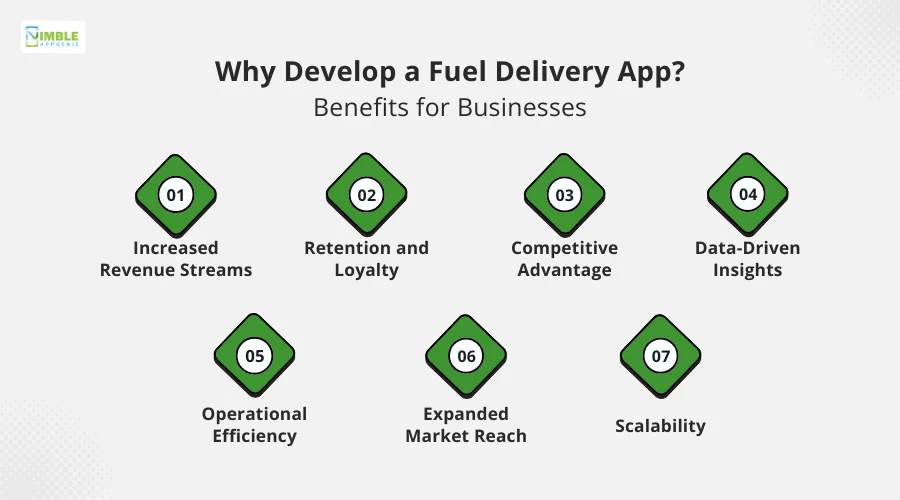
1. Increased Revenue Streams
The advent of a fuel delivery app can lead to betterment when it comes to revenue for one’s business.
In addition to fuel sales, an app can help you enjoy money from a variety of monetization strategies that include surcharges for basic conveniences or upsells on pricier fuels and supplementary products like car washes, oil changes, etc.
These services have added-value features & improve profitability to partners.
2. Retention and Loyalty
It is the ultimate goal of every business is to have a customer base that remains loyal for as long as time allows.
By creating a fuel delivery app, you are offering convenient, quick, and tidy service that increases the level of customer comfort. Presenting them with meaningful connections and putting them first can never let you go out of style.
3. Competitive Advantage
In current times, differentiation is key.
Providing the option of a fuel delivery app to your customers labels you as an innovator in addition to keeping with industry standards.
Since the service is not offered by all your competitors, this appeals to a broad customer base and differentiates you from competitors. Also, creates successful branding for the company therefore gaining more market share.
4. Data-Driven Insights
Fuel Delivery App gets rich insights into customer behavior, choice, and market trends.
This is the sort of data that offers actionable insights for operational efficiencies, more targeted marketing campaigns, and uncovering where new markets are built from.
Making Decisions Based on Data will let you provide better services.
5. Operational Efficiency
Every business needs to streamline its operations.
A diesel delivery app improves efficiency by providing features such as route optimization, inventory management, and automated scheduling.
In this way, it allows any business to keep its costs down by reducing manual tasks and setting up resource allocations in the correct place across your business.
6. Expanded Market Reach
With an on-demand fuel delivery app, businesses can add new market sectors to their customer base.
Fuel delivery apps allow businesses to reach customers in underserved areas, expanding their market reach and boosting sales.
7. Scalability
To scale and evolve, a business has resistible conditions. As you know that’s not the case with the fuel delivery app, it can scale with the business, unlike other types of models.
Businesses can scale significantly and become market leaders by expanding delivery areas, adding new services, and acquiring and accumulating more customers.
Famous Fuel Delivery Apps: Get Inspired
Several innovative apps have emerged to cater to the growing demand for convenient and hassle-free fueling.
Let’s explore some of the most successful fuel delivery apps that have captured the market and inspired countless entrepreneurs. Get inspired by them:
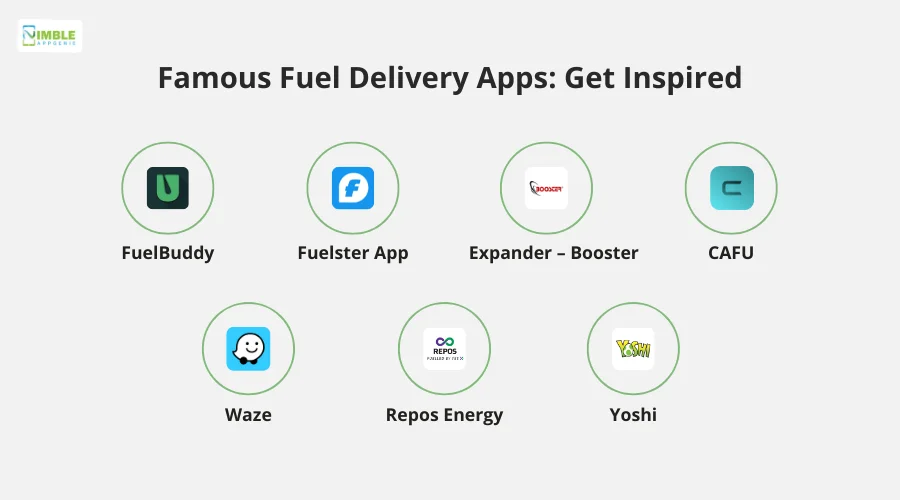
► FuelBuddy
FuelBuddy is a famous fuel delivery app that is designed to simplify the fuel purchasing process.
With this app, users can easily locate nearby gas stations, compare fuel prices, and even pay for gas through the app.
Besides that, the popularity of this app stems from its features like loyalty rewards, and real-time fuel availability. They aim to save users time and money while filling up their tanks.
► Fuelster App
Fuelster is a startup for delivering fuel on demand that brings gas stations to you.
With the app, users can select the kind of fuel they want, and the vehicle they drive, and have peace of mind that the delivery will be on time.
The app offers real-time tracking to users involved in the delivery process.
► Expander – Booster
Booster offers top-notch fuel delivery services to its users.
The fuel app makes sure to bypass traditional fuel delivery by sourcing fuel directly from terminals and pumping it into your vehicle, removing the need for polluting tanker trucks and gas station visits.
► CAFU
With CAFU, you can avoid the hassle of filling up & enjoy the convenience of fuel delivered directly to your location.
CAFU’s strategic alliance with ENOC, a leading fuel provider in the UAE, guarantees customers premium gasoline at competitive prices. The company has expanded its operations beyond the UAE, with services now available in Riyadh and Jeddah, Saudi Arabia.
► Waze
Waze is primarily known as one of the best driving direction apps.
But it also assists drivers in finding the best fuel deals. By utilizing real-time user input, the app offers the right information about gas prices, station locations, and fuel types.
► Repos Energy
Offering fuel services in the largest city in the Philippines, Repos Energy provides an app that uses green energy to deliver red diesel.
With Repos, you don’t have to worry about those uncomfortable waits in line or about whether you’ll run out of gas before the next pump appears.
Fuelled by support from the industry and a customer-focused outlook, Repos Energy has made itself a top choice for companies and ordinary people who need a smooth fuel supply.
► Yoshi
Unparalleled expertise and a fully equipped range of related services have made Yoshi the leading provider of app-based fuel delivery.
Thus, Yoshi aims to become more than just a fuel vendor; it is a one-stop shop for all your car care needs. The app even allows users to book an oil change, car wash, or fuel delivery at the same time.
Having explored the landscape of fuel delivery apps, let’s delve into the critical features that can set your app apart and drive user satisfaction.
Features to Integrate into Your Fuel Delivery App
Features can make or break your app’s success. And this statement is true in every industry, including the fuel delivery business.
If you want to create an on-demand fuel delivery app, you need the best feature which is what this section is about. Get to know them:
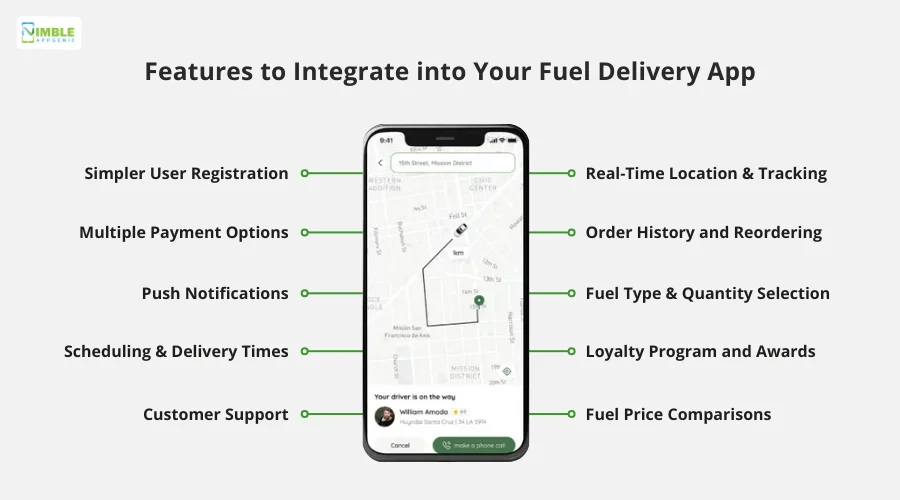
1] Simpler User Registration
A streamlined registration process is crucial to the user experience.
Allow users to input the necessary information including name, address, payment details, and vehicle information. Plus, incorporate social login options for faster account creation.
This way, the onboarding experience based on user preferences or the location of the user’s engagement from the start is heightened.
2] Real-Time Location and Tracking
You can provide users with peace of mind by offering them real-time tracking of their fuel delivery. Utilize GPS technology to display your delivery driver’s location on a map.
Provide features like estimated time of arrival and live updates concerning the status of the delivery to keep your users informed.
3] Multiple Payment Options
Variety is Key to Meet Customers ‘ Preferences.
By integrating several payment gateways, you can offer them an option to choose from popular payment methods such as credit cards, debit cards, digital wallets, or cash on delivery and allow them to confirm their delivery.
One more thing, ensure secure payment processing and data protection to inspire trust.
4] Order History and Reordering
You can improve customer convenience by allowing them to look back at previous orders. For which, make sure to provide detailed order history info on the date, time, fuel type, and amount paid for each order.
Furthermore, one-click reordering should also be integrated for delivery of frequently purchased fuel types which saves time.
5] Push Notifications
Inform users in time with push notifications services.
Sending alerts for order updates, delivery statuses, promotions, and service announcements, personalized according to user preferences enhances the relevance of notifications.
This way, you can communicate and inform them about their request timely.
6] Fuel Type and Quantity Selection
Provide a variety of fuel types so that users can meet the needs of different cars.
Let users specify the exact quantity of fuel necessary for accurate ordering. To help them, you can think about giving recommendations based on the type of vehicle and usage pattern to assist users.
7] Scheduling and Delivery Times
Offer flexibility to users by providing early ordering and delivery times for fuel.
Different delivery time slots can cater to different schedules and needs. Features such as recurring deliveries for regular customers can simplify the process of ordering and enhance their experience.
8] Loyalty Program and Awards
With a rewards policy, build up customer loyalty.
Offer incentives like discounts, free deliveries, and multiple offers that are not mentioned on the platform because incentives are based on a referral’s purchase history.
A tiered system of loyalty levels will create a sense of moving forward and stimulate repeat business.
9] Customer Support
If you want to create a fuel delivery app that’ is successful in the market, make sure to offer exceptional customer support through multiple channels.
Provide in-app chat, email, and phone support options to meet different user preferences. Your experts can offer fast response times and quick issue resolution to enhance customer satisfaction.
10] Fuel Price Comparisons
Allow users to make informed decisions with real-time fuel price comparisons. Present the prices of different suppliers or within the local area for users.
Raise people’s awareness about price fluctuations and trends showing how good deals are available now. This will offer them transparency and help them to make better decisions.
Step By Step App Development Process: Fuel Delivery App
How to create a fuel delivery app? That’s a question investors should consider when exploring new opportunities in the on-demand economy. So, it’s best to understand the app development process to grasp a better understanding of the concept.
Get to know the step-by-step guide on how to develop a fuel delivery app:
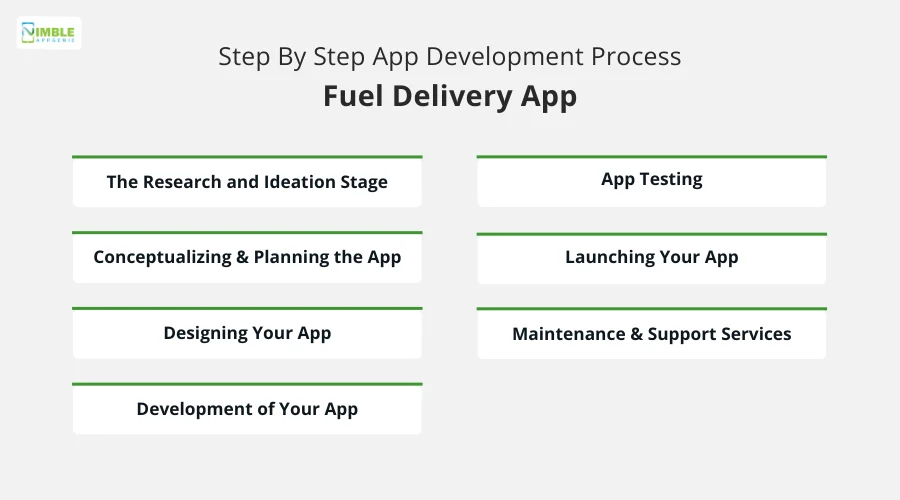
Step 1: The Research and Ideation Stage
To build a fuel delivery app, do your market research thoroughly.
Research your target users, investigate the apps of competitors, and find a distinctive selling point (USP) for your app.
Perform a SWOT analysis of internal strengths and weaknesses, external opportunities that benefit from your unique ideas, as well as the challenges of the industry or business.
Step 2: Conceptualizing and Planning the App
You need to plan your app the way your users want, so make sure to have a detailed app concept with core features.
Create user personas that will help you understand your audience better. Plus, make sure to develop a comprehensive app roadmap outlining key features and functionalities.
Conduct thorough market research to identify potential challenges and opportunities.
Step 3: Designing Your App
Moving further, time to go for UI/UX Design.
Create detailed wireframes and mockups to visualize appealing designs; this will give you an overview of the app’s structure, layout, and user flow.
Furthermore, consider incorporating elements like color schemes, typography, and imagery that align with your brand identity.
Step 4: Development of Your App
This is where your idea is transformed into a functional product.
Developing a fuel delivery app requires a robust technological foundation. This includes choosing the right tech stack, including frontend and backend development, and database management.
Careful planning and execution are necessary to build a scalable and efficient fuel delivery app that meets user needs.
Step 5: App Testing
It’s not possible to build a fuel delivery app without proper app testing.
So make sure to test the app and debug it. Besides that, you should also make sure that there are no technical issues, errors, or glitches that can hamper user experience.
Also, don’t forget to conduct security testing developments to secure user data on your platform.
Step 6: Launching Your App
It’s time to launch a fuel delivery app.
This involves submitting the app to the app store or publishing your app to the Play Store, so make sure to craft compelling app descriptions, visually appealing icons, and screenshots to get accepted quickly.
Once your request is approved, make sure to create a buzz around your launch through social media marketing, press releases, and targeted advertising.
Step 7: Maintenance & Support Services
Once you launch your fuel delivery app, maintenance and support services should start.
This includes ongoing monitoring, updates, bug fixes, and customer support. We suggest you implement a robust system to track app performance, gather user feedback, and address issues quickly.
Having outlined how to develop an on-demand fuel delivery mobile app, it’s important to understand the challenges, which is what our next section is about.
Development Challenges in Fuel Delivery App
Knowing challenges is important. If you want to build a fuel delivery app that’s successful in the market, understanding and proactively addressing potential obstacles is crucial.
Get to know about them:
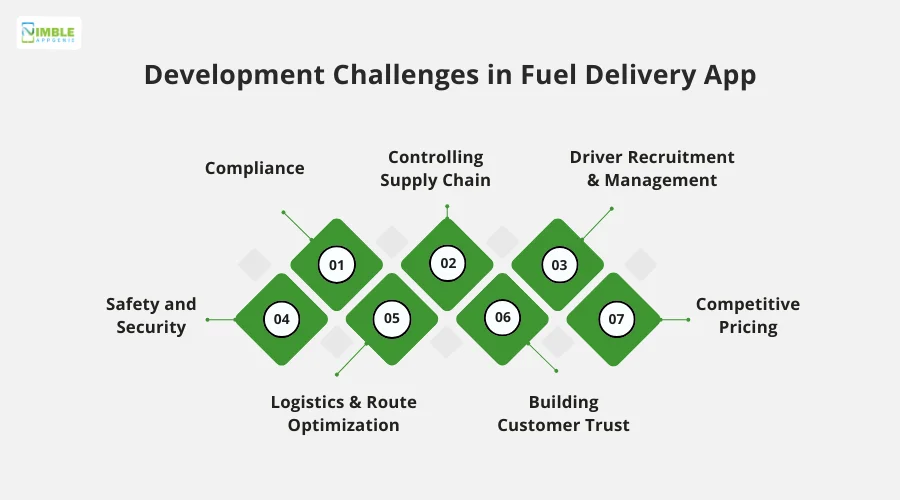
-
Compliance
You need to deal with a whole host of fuel delivery regulations, which is an even tougher nut to crack.
It is important to comply with local, state, and federal laws regarding licensing, permits, etc. It will take comprehensive legal advice as well as watch over-regulation developments.
-
Controlling Supply Chain
Supplying fuel in a consistent, reliable manner is key. So make sure to collaborate with fuel suppliers.
Managing inventory levels and optimizing your delivery routes, fuel prices, and availability can affect the operations and satisfaction of customers due to variations.
-
Driver Recruitment & Management
Locating, hiring, and retaining competent drivers is an ongoing issue. Efficient Driver onboarding, training, and management systems must be in place in your app.
Amid problems such as high driver turnover, safety issues and the weight of a 12-14 hour-a-day workload management is something to consider.
-
Safety and Security
Ensuring the safety of your data and app security is paramount.
We suggest that you implement strict safety protocols and regular app audits, and providing driver training is essential.
Overlooking this might tarnish your app’s reputation and lead to a decline in user adoption.
-
Logistics and Route Optimization
Efficient route planning and delivery optimization are vital for maximizing operational efficiency and reducing costs.
Implementing advanced logistics software and leveraging real-time data can help optimize your delivery routes and improve driver productivity.
-
Building Customer Trust
Establishing trust with customers is the need of the hour for long-term success.
Providing excellent customer service, transparent pricing, and a reliable platform is key to building trust.
Furthermore, making sure to implement a robust customer feedback system and address customer concerns promptly can help strengthen customer relationships.
-
Competitive Pricing
Offering competitive fuel prices is essential to attract and retain customers.
It’s important to balance profit margins with customer satisfaction, which requires careful analysis of market trends and competitor pricing.
Moreover, implement dynamic pricing strategies and explore cost-saving measures to maintain competitive advantage.
Cost to Develop a Fuel Delivery App
A common question investors have is “How Much Does It Cost to Develop a Fuel Delivery App?”
The cost to develop a fuel delivery app can range from $30,000 to$150,000+. However, cost is a variable factor and it can change as per the varying project requirements and complexity.
Here is a breakdown of the cost to develop an app to get a better idea:
| App Complexity | Cost Range |
| Basic (core features like user registration, order placement, and tracking) | $30,000 – $50,000 |
| Medium (additional features like in-app messaging, multiple payment options, and loyalty programs) | $50,000 – $100,000 |
| Advanced (complex features like real-time pricing, fuel type options, and advanced analytics) | $100,000 $150,000+ |
Note: This is not an accurate cost, it’s just an estimate. If you want to know about the right cost to make a fuel delivery app, make sure to consult with an experienced mobile app development company with all your project requirements.
Time to Create a Fuel Delivery App
So, “How much time does it take to build a fuel delivery app?”
The development time can range from 2 to 9+ months. Simply put, the factors that affect the cost also affect the time.
If your idea is complex, then the time taken will be more. Whereas, if developers are working on simple ideas with minimalistic design and basic features, this might not take much time.
This quick overview of time and complexity will help you understand better:
| App Complexity | Development Time |
| Basics (core features) | 2-4 months |
| Medium (additional features like loyalty programs and in-app messaging) | 4-6 months |
| Advanced (complex features like real-time pricing and advanced analytics) | 6-9 months |
To successfully develop a fuel delivery app within the desired timeframe, partnering with experienced app development experts is crucial. Our next section might help you with that.
Nimble AppGenie – Your Partner to Develop a Fuel Delivery App
The fuel delivery app market is rapidly expanding. To capitalize on this trend, it’s best to partner with an experienced fuel delivery app development company i.e. Nimble AppGenie.
You can opt for our development services, from conceptualization to launch & beyond, our team provides end-to-end support. We don’t just build apps; we develop digital solutions that strengthen your online presence and are tailored to your specific requirements.
If you have an idea then hire mobile app developers from us to develop your project!
Conclusion
Creating a successful fuel delivery app requires a blend of market understanding, technological expertise, and strategic planning. By carefully considering factors such as market trends, user needs, and the competitive landscape, you can develop a fuel delivery app that stands out.
Nimble AppGenie offers comprehensive app development services to help you navigate the complexities of this burgeoning market.
Our team of experts can guide you through every stage of the process, from ideation to launch and beyond. Let us be your partner in transforming your fuel delivery vision into reality.
FAQs
Conduct thorough market research, focus on user experience, build a strong team, prioritize security, and continuously monitor and improve your app based on user feedback.
By partnering with Nimble AppGenie, you can overcome these challenges and build a successful fuel delivery app.

Niketan Sharma is the CTO of Nimble AppGenie, a prominent website and mobile app development company in the USA that is delivering excellence with a commitment to boosting business growth & maximizing customer satisfaction. He is a highly motivated individual who helps SMEs and startups grow in this dynamic market with the latest technology and innovation.
Table of Contents




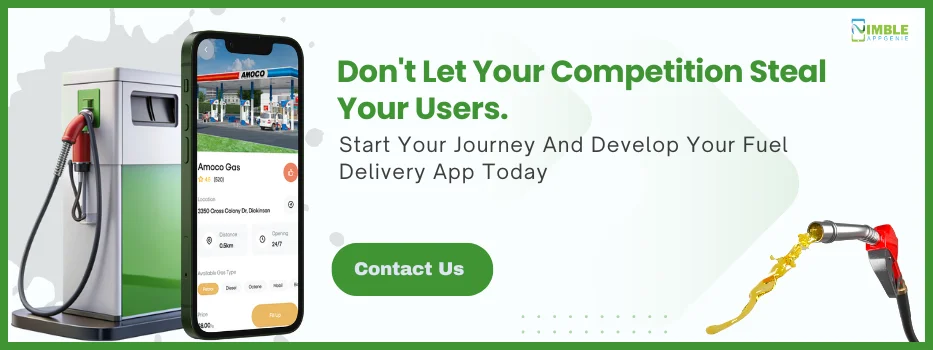
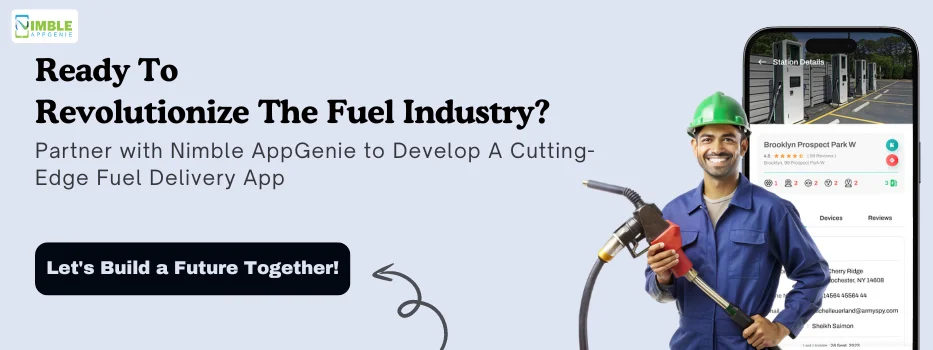
No Comments
Comments are closed.